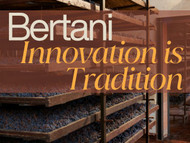Bertani: A Tradition of Innovation
Rob Ward on 26 Feb 2025
Bertani has an illustrious heritage with more than a century and a half of winemaking, and still proudly produces some of the finest wines of the Veneto, including esteemed estate Valpolicella Classico Superiore DOC and Amarone della Valpolicella Classico DOCG wines.
The Bertani journey began in 1850 when a young Gaetano Bertani travelled to Burgundy to study new and innovative viticultural techniques under Jules Guyot. Inspired by Guyot’s genius for vine husbandry, Bertani and his brother founded Cav. G.B. Bertani in 1857 in Valpolicella's Valpantena district - a pre-alpine valley to the north of the city of Verona, in what was then the Kingdom of Venetia (now Veneto).
At that time, Valpolicella wine production was dominated by the sweet, recioto style, achieved by concentration through drying the fruit after harvest. Bertani's first innovation in the region was to make and market a dry, Burgundy-inspired, style of wine: bringing into being the brand Secco Bertani.
Central to Bertani's philosophy is working with the terrior of the region to create unique wines which express a sense of place, with an unmistakable elegance and stylistic profile. To this end, in 2019, the Tenute Novare estate’s single-vineyard 'Cru' project was launched. Ognisanti comes from a single vineyard above the old chapel of the same name, while Le Miniere comes from a site which had been mined for pyrites and manganese until the 1890s. True to Gaetano's legacy, Bertani continues to combine innovation and tradition, producing wines which are among the most vibrant and dynamic of the region, while modelling sustainable viticultural practices.
In 1958, Bertani was instrumental in the creation of Amarone, which has since become Valpolicella's most famous wine. It was known that barrels of wine intended to become sweet recioto would occasionally ferment dry, leading to an exceptionally concentrated, powerful and velvety red wine. This 'recioto scapata' ('escaped recioto') was generally considered to be a quirk, and never commercialised. Bertani’s winery manager, Ernesto Barbero, saw its potential: persevering and perfecting the style through long ageing to create a wine that was not only rich and full-bodied, but also elegant and complex, with outstanding finesse.

Today, the Bertani estate covers 200 hectares, of which 65 are vineyards, in two parts of the Valpolicella region as well as in Soave further to the east, and produces a superb range of red and white wines.
Foremost in the Bertani estates is the Tenuta Novare, at Arbizzano di Negrar, in the heart of Valpolicella Classico. Here, on calerous-marl soils, Corvina Veronese and Rondinella grapes are grown on Guyot-trained vines, for the famed Amarone Classico. The vines are meticulously cultivated by hand, without tractors or machine harvesters, yielding fruit of exceptional quality.
Nearer to the Bertani cellars, the vineyards of the Valpantena exhibit superior drainage, fine sunny aspect and the diurnal range essential for optimising ripeness while balancing freshness. Here, the steep slopes warrant hand-hewn stone terraces, to prevent the soils from being washed downhill by rainfall, and to provide access for workers to tend the vines.

The Bertani Amarone della Valpolicella Classico is a blend of the native Corvina Veronese and Rondinella grapes. While both tend towards lightness, low to moderate tannins and tart cherry flavours, the drying process intensifies and modifies their character, resulting in a wine of richness, complexity and exceptional capacity for long cellaring. Amarone Classico is indeed a classic in every way.
Harvesting is entirely by hand, and takes place in early September for grapes destined for Amarone (around two weeks later for the other wines). Bunches are carefully selected, and only pristine fruit is brought to the winery in small trays to prevent bruising or crushing. Upon reception, the bunches are sorted a second time, and then laid in single layers on bamboo mats in specially-constructed drying rooms (fruttai). The drying of the fruit in this manner– the classic messa a riposo method – not only concentrates but also creates a complex and unique set of new attributes, which cannot be achieved in any other way.

In order for traditional drying to be effective, fruit must be in perfect condition when harvested. Grape selection in the vineyard is vital, and temperature and humidity in the fruttai is moderated to prevent the growth of damaging grey rot (Botrytis cinerea). At Bertani, grapes for the Amarone della Valpolicella Classico are laid to dry for around 80 days – rather less than other producers – losing between 30 to 50% of their weight during this time, depending on weather conditions.
After maceration, a slow fermentation starts takes place over 30 days at room temperature, before the Amarone Classico is racked into 70 hectolitre barrels, where it will rest for seven years, before stabilising and maturing in bottle for a further 12 months prior to release.

Over the years, some producers have released noticeably sweeter Amarone, with higher residual sugar. This imparts an apparent softness, but this comes at the expense of subtlety. By contrast, Bertani's timeless style has remained virtually unchanged since the first release. Despite changes to climatic conditions, expertise in both the vineyard and winery continues to produce a wine which finely balances acidity, fruit, alcohol and tannin, and which both enables and rewards patient cellaring.
Mature and beguiling, yet only just breaking into its stride, the 2015 Bertani Amarone Classico has a garnet colour, with hints of tawny around the rim, and a glorious bouquet of cherry liqueur, dark chocolate and wafts of roasting coffee. With exposure to air, it reveals hidden depths: black truffle, leather, grandfather’s pipe tobacco, autumn leaves, musk, charcuterie and rose petal. Supremely velvety, full-bodied and mellow, it shows power, restraint and magnificent refinement. With marvellous length on the palate, this Amarone will cellar for years to come.




